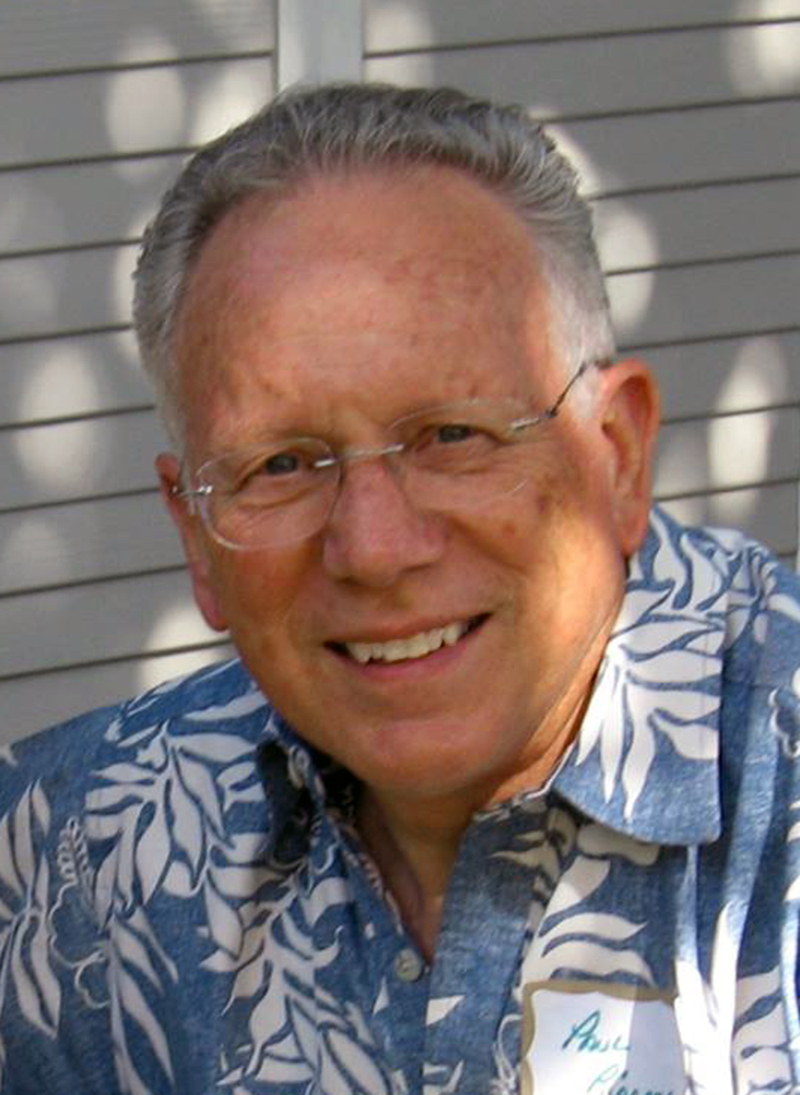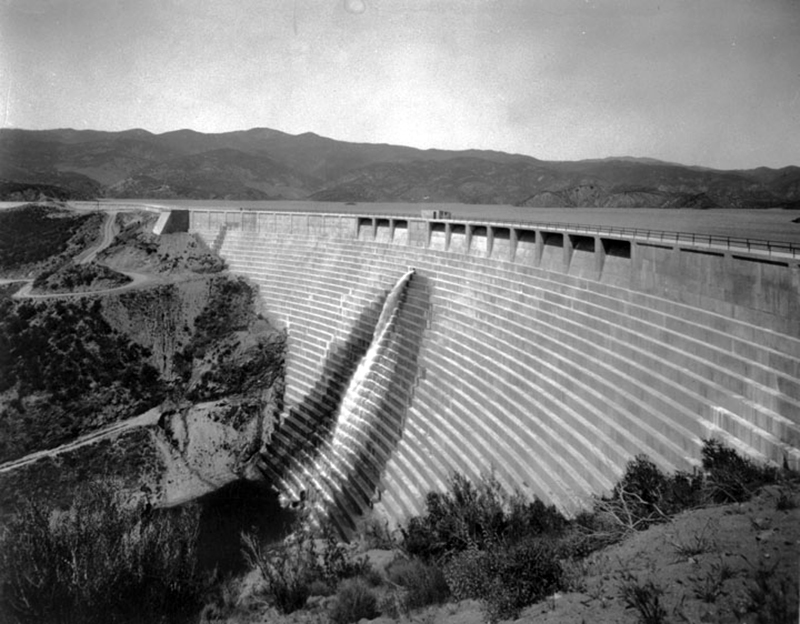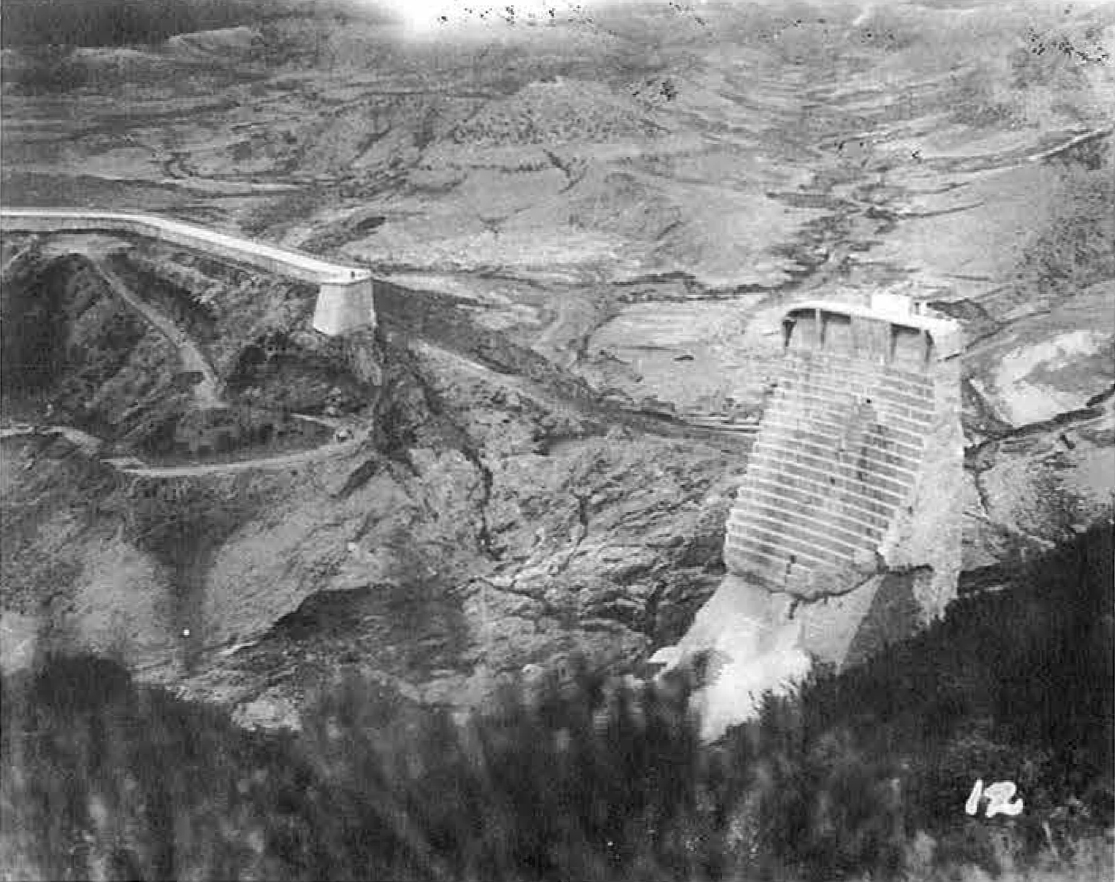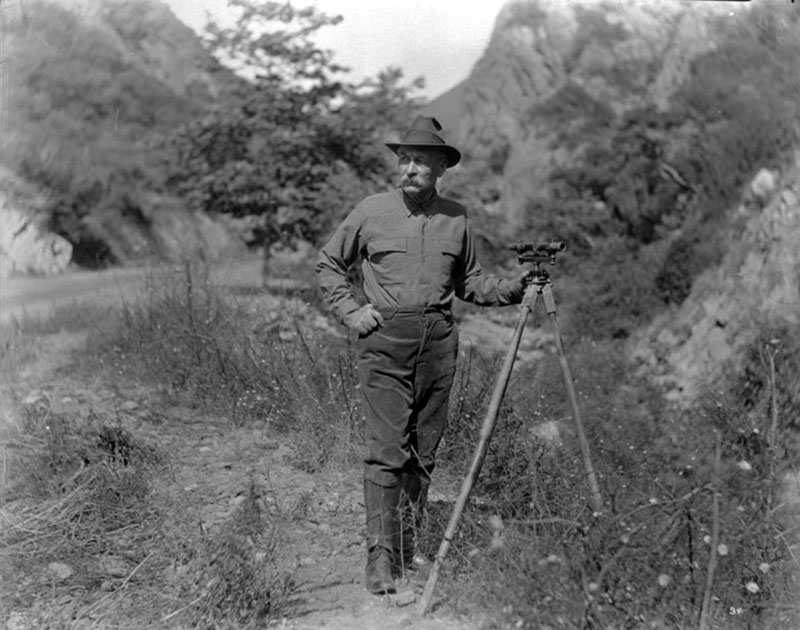|
|
THE NIGHT OF THE FLOOD:
The Failure of the Saint Francis Dam
By Paul H. Rippens
Los Angeles Corral of Westerners: The Branding Iron, No. 212 | Summer 1998.
|
To the north of the town of Saugus, in San Francisquito Canyon, a disaster of epic proportions was about to occur. One that would claim over 450 lives, second only to the great San Francisco earthquake of 1906. The Saint Francis Dam, part of the Los Angeles Aqueduct system that supplies water for Los Angeles, was about to fail. Rumors had spread in the canyons below the dam that the structure was unsafe and that it had several major leaks. This con cern was also in the mind of dam keeper Tony Harnischfeger when he called Los Angeles on the morning of March 12 to advise William Mulholland, chief engineer of the city's water department, that another leak had occurred. Mulholland and his assistant Harvey Van Norman made the two hour trip to the dam and, following an inspection, proclaimed the dam to be per fectly safe. However, there were forces no one suspected that would cause the dam to collapse, releasing over 12 billion gallons of water on a destructive rampage through the canyons and valleys of Los Angeles and Ventura County. At 11:57:30 P.M., the dam could no longer hold back the tremendous pressure of the water and, as the east abut ment began to fail, the water started its course toward the Pacific Ocean, 53.8 miles distant.
In July 1905, the voters of Los Angeles approved a $1,500,000 bond issue to acquire Owens Valley lands and water rights. An additional bond issue of $23,000,000 was passed in 1907 to construct what would become one of the engineering marvels of its time. Construction of the aqueduct began in 1908 and was completed in 1913, on time and under budget, an unheard of thing today. On November 5, 1913, some 40,000 Angelenos turned out to watch the Owens River water cascade into a San Fernando reservoir, later to be called the Van Norman Reservoir. "There it is," said Mulholland, "take it." According to some officials, with the aqueduct the city had all the water it would ever need. The city constructed two power plants in San Francisquito Canyon with Power House No. 1 regulating the water com ing into Los Angeles. Everything seemed to be perfect until certain people in the Owens Valley started to rise up against the city and its aqueduct. On May 21, 1924, a group of men dynamited the aqueduct spillway gate near Lone Pine. This would be only the first of many acts of sabotage to the city's water system. Following these acts, Mulholland decided to construct an additional storage facility to insure that the city would have adequate water. Mulholland was also concerned that the Elizabeth Tunnel, which was bored through the San Andreas Fault, could fail in a seismic event. He decided to construct a new reservoir that would be formed by the Saint Francis Dam, a 688 foot long arched dam with an additional 588 foot wing dike on the west side. The reservoir would cover 600 acres and have a capacity of 38,168 acre feet. Work began on the dam in 1924 with the pouring of concrete commencing in August of that year. By 1926 the dam was completed and the reservoir began to fill. As the water level rose behind the great dam, leaks and cracks appeared not only on the face of the dam, but at the east and west abutments. The cracks in the concrete were packed with oakum in an effort to seal off the leaks. This operation was not entirely successful, for water continued to permeate through the downstream face of the dam. Workers installed a two-inch pipe to the leak on the west abutment, adjacent to the inac tive San Francisquito Fault line, and the water collected and carried down to dam keeper Hamischfeger's cottage for home use. By April 1927, the reservoir had filled to within ten feet of the spillway, and most of the month of May saw water elevations within three feet of the overflow. No significant change was detected in the seepage from either abutment other than what could normally be expected from the increased pressure. William Mulholland stated "Of all the dams I have built and of all the dams I have ever seen, it was the driest dam of its size I ever saw." The water level in the St. Francis Reservoir rose steadily until March 7, 1928, when Mulholland ordered that no more water be turned into the reservoir. The level was with in three inches of the spillway and would tend to waste over the dam in case of high wave action caused by the prevailing down canyon winds. The reservoir held enough water to last the entire city for a year. Meanwhile, gossip continued by inhabitants of the canyon regarding the leaking dam and the amount of water flowing down the canyon. Whenever neighbors in the canyon stopped to talk, the subject invariable was about the dam. One canyon dweller said: I stood there and talked to some friends of mine working in the rock quarry. One day we were talking about that leak increasing and I told them I said, "It looks like that leak is getting pretty bad," and they asked me if there was any danger of the dam breaking and I told them I didn't know. The morning of March 12 began like any other. The keeper of the dam went about his work which included checking for new leaks. His concern over a leak at the west abutment prompted the call to Mulholland and the subsequent inspection. At Powerhouse No. 2, a short distance down canyon from the dam, the day shift was ready to start its tour at seven, while the men who had been on duty since eleven the previous night looked forward to breakfast and a late bed. Mothers readied their children for school and prepared breakfast for their men. Life was quiet and serene at the homes located close to the powerhouse. As evening fell, families gathered to visit and to pass the time. A lone motorcyclist made his was up the canyon on his way to Powerhouse No. 1. A mile past the dam he stopped after he heard a loud noise. He lis tened to what he thought was the sound of a landslide, but they were common in the canyon, so he continued on his way.
At 11:57:30 P.M. people in Los Angeles, some 50 miles away, noticed the lights flicker momentarily. Bureau of Power and Light operators noticed a sharp drop in voltage for two seconds. At the Saugus substation of the Southern California Edison Company, the transmission line to Lancaster shorted out, blowing up an oil switch in the station. High above Powerhouse No. 2, the surge chamber attendant was awakened by what he thought to be an earthquake, but the vibrations grew stronger. Suddenly the lights dipped to a dull glow, remained for a second or two and then went out. He knew something was wrong at the powerhouse. The attendant was right, something was wrong at the powerhouse, for a wall of water 120 feet high had swept over the building washing away everything except the generators. Of the twenty-eight workmen and their families living at Powerhouse No. 2 only three people survived. The flood had taken only five minutes to travel from the site of the dam to the power house. There was nothing that could have stopped the rush of the water as it stripped San Francisquito Canyon bare. Buildings, cars, livestock, trees, people and the soil itself were washed toward the ocean. By now authorities were becoming aware of what had happened. Powerhouse No. 1 sent a man down canyon to investi gate; he reported that the dam was gone and the reservoir was empty. Downstream, the rampaging water continued its destructive path taking out the Edison substation in Saugus as it made its turn to the west. The wall of water, still 75 feet high, swept over thebuildings of Castaic Junction and destroyed the bridge across the Santa Clara River. At Kemp (Blue Cut), the Edison Company's camp of workers was right in the path of the flood. The night security officer, Ed Locke, heard the rumbling vibrations of the approaching water but could not determine what the problem was until it was too late. The flood wave struck the hills west of the camp and rebounded up the valley. Locke tried to awaken the sleeping men but his efforts were, for the most part, futile. Of the one hundred fifty men in the camp, eighty-four perished in the cold floodwaters, including the heroic watchman. The onslaught of the flood swept across the Camulos Ranch. The water tore through the groves of orange trees, ripping them out of the·ground. It did little to slow the advance of the water as it continued toward Fillmore and Santa Paula. At 1:30 AM. March 13, 1928, the night telephone operator in Santa Paula received an urgent call from the chief operator of the Pacific Long Distance Telephone Company. She told the Santa Paula operator that the St. Francis Dam on the Los Angeles Aqueduct had broken and released a tremendous wall of water that was sweeping down the Santa Clara Valley. The Santa Paula operator immediately called Highway Patrolman Thorton Edwards to notify him of the impending disaster. Edwards quickly dressed and boarded his motorcycle to start a wild ride that would earn him the title "Paul Revere of the St. Francis Flood." He knocked on doors to awaken people and tell them of the pending flood. Finally, he used the siren on the cycle and raced up and down the streets in the danger zone in an attempt to warn the residents. The flood waters roared past Fillmore, destroying homes in the low lying areas and taking more lives as it continued toward Santa Paula. Bridges across the Santa Clara Valley river were swept away one by one. As the river level rose in Santa Paula, homes lining the river were floated off their foundations or splintered into pieces depending on their location. Homes became house boats and sailed around areas of the city, one ending up four blocks from its original location. The water continued past Saticoy and under the Montalvo bridge and finally, five and one-half hours after it began, the flood waters, still 15 feet high and now semi-solid with mud, debris and bodies, reached the Pacific Ocean. The flood was over, and the huge clean-up began.
The City of Los Angeles accepted the responsibility for the disaster and agreed to pay the cost of the clean-up and reconstruction. An official report stated that the City of Los Angeles expended $9,392,487.57 in rehabilitation work and the settlement of claims. From the onset, Mulholland accepted the blame, telling the Coroner's inquiry that he "only envied those who were killed." His final statement at the inquest told how he felt when he said "Don't blame anyone else, you just fasten it on me. If there was an error in human judgment, I was the human." But what had caused the great dam to fail? Theories were many but recent findings take most of the blame off William Mulholland and place it on events and fac tors that neither he nor his engineers knew about at the time of the construction of the dam. In "The St. Francis Dam Disaster Revisited," J. David Rogers points out that the area of San Francisquito Canyon where the dam was constructed has many ancient mega landslides of which Mulholland was unaware. These slides contributed to the· overall failure of the structure. Rogers discusses the effects of uplift pressures on gravity dams. He states: In lay terms, uplift pressures are caused by bouyance due to simple sub mergence or percolation. When water fills behind a dam, the dry dead weight of the dam is significantly reduced because of the water pressures within the foundation rock beneath the dam are pushing upward. So the failure of the St. Francis Dam was not caused by anything that Mulholland did, but because of things he did not know. As pressures built, the great dam was lifted upward. At the same time, the east abut ment area had become saturated with mois ture and as the structure lif ted, the mountain side on the east side slid into the reservoir creating a giant opening for the water to escape. As the water started its rush down canyon, the dam leaned to the east and broke apart. As the dam fell in gigantic pieces, a flood wave estimated at 1.7 million cubic feet per second began its race to the Pacific Ocean. Today remnants of the dam remain in San Francisquito Canyon, but memories of the disaster remain only in the many books written on the subject. Unfortunately William Mulholland died in 1935 without knowing what really happened to cause the night of the flood. Suggested Readings Davis, Margaret Leslie. "Rivers in the Desert: William Mulholland and the Inventing of Los Angeles." Hoffman, Abraham. "Vision or Villainy: Origins of the Owens Valley-Los Angeles Water Controversy." Kahrl, William. "Water and Power: The Conflict over Los Angeles' Water Supply in the Owens Valley." Nadeau, Remi. "The Water Seekers." Southern California Quarterly Vol. 79, No. 3 (Fall 1997). Outland, Charles F. "Man-Made Disaster: The Story of St. Francis Dam."
©Paul H. Rippens | Used/archived by permission of the author. |
SEE ALSO:
Transcript of Coroner's Inquest
Hall of Justice 1928
Verdict of Coroner's Jury
Arizona Report 1928
Popular Science 1964
• Rippens Story of Dam Disaster (1998)
Vital Lesson for Today (ASDSO 2018)
At Dam Site 3-14-1928
With Van Norman at Dam Site 3-15-1928
Coroner's Jury Inspects 3/1928
Hall of Justice 1928
Fountain 1940s
Aqueduct Memorial Garden Opens at Mulholland Fountain: Story 10-23-2013
Mulholland Fountain & Aqueduct Garden: Photo Gallery 11-10-2013
|
The site owner makes no assertions as to ownership of any original copyrights to digitized images. However, these images are intended for Personal or Research use only. Any other kind of use, including but not limited to commercial or scholarly publication in any medium or format, public exhibition, or use online or in a web site, may be subject to additional restrictions including but not limited to the copyrights held by parties other than the site owner. USERS ARE SOLELY RESPONSIBLE for determining the existence of such rights and for obtaining any permissions and/or paying associated fees necessary for the proposed use.
 The night of March 12, 1928, was still; the residents of the Santa Clara River Valley northwest of Los Angeles relaxed following another beautiful spring day. Rains had graced the region in previous days but this day had been dry with scattered clouds.
The night of March 12, 1928, was still; the residents of the Santa Clara River Valley northwest of Los Angeles relaxed following another beautiful spring day. Rains had graced the region in previous days but this day had been dry with scattered clouds.


















